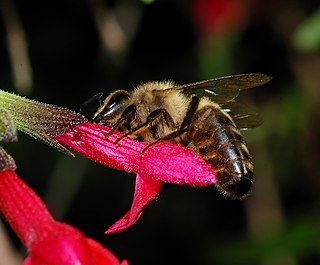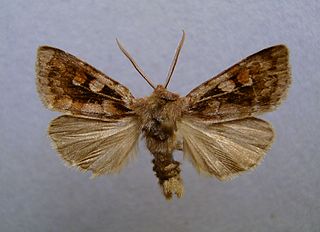
Hermann Müller was a German Social Democratic politician who served as the Foreign minister (1919–1920), and twice as the Chancellor of Germany in the Weimar Republic. In his capacity as Foreign Minister, he was one of the German signatories of the Treaty of Versailles.

The Buckfast bee is a breed of honey bee, a cross of many subspecies and their strains, developed by Brother Adam, who was in charge of beekeeping from 1919 at Buckfast Abbey in Devon in the United Kingdom. Breeding of the Buckfast bee is now done by breeders throughout Europe belonging to the Federation of European Buckfast Beekeepers (G.D.E.B.). This organization maintains a pedigree for Buckfast bees, originating from the time of Brother Adam.
Within biological taxonomy, a honey bee race would be an informal rank in the taxonomic hierarchy, below the level of subspecies. It has been used as a higher rank than strain, with several strains making up one race. Therefore, a strain is a lower-level taxonomic rank used at the intraspecific level within a race of a subspecies. Strains are often seen as inherently artificial concepts, more usually within biology as characterized by a specific intent for genetic isolation, however, within beekeeping circles, strain is more likely to be used to describe very minor differences throughout the same subspecies, such as the color ranges of A. m. carnica from brown to grey. Within A. m. ligustica there are two races, the darker leather brown northern Italian bee from the Ligurian Alps region which was discovered to be resistant to acarine in the 1900s, while the other Italian bee race, from regions near Bologna and further south, was highly susceptible to acarine and within this race there are two color strains, the traditional Italian yellow and a rarer all-golden color.

The European dark bee is a subspecies of the western honey bee, evolving in central Asia, with a proposed origin of the Tien Shan Mountains and later migrating into eastern and then northern Europe after the last ice age from 9,000BC onwards. Its original range stretched from the southern Urals in Russia through northern Europe and down to the Pyrenees. They are one of the two members of the 'M' lineage of Apis mellifera, the other being in western China. Traditionally they were called the Black German Bee, although they are now considered endangered in Germany. However today they are more likely to be called after the geographic / political region in which they live such as the British Black Bee, the Native Irish Honey Bee, the Cornish Black Bee and the Nordic Brown Bee, even though they are all the same subspecies, with the word “native” often inserted by local beekeepers, even in places where the bee is an introduced foreign species. It was domesticated in Europe and hives were brought to North America in the colonial era in 1622 where they were referred to as the English Fly by the Native Americans.

The Carniolan honey bee is a subspecies of the western honey bee. The Carniolan honey bee is native to Slovenia, southern Austria, and parts of Croatia, Bosnia and Herzegovina, Montenegro, Serbia, Hungary, Romania, and Bulgaria.

San Leonardo is a comune (municipality) in the Italian region Friuli-Venezia Giulia, located about 60 kilometres (37 mi) northwest of Trieste and about 25 kilometres (16 mi) east of Udine, and borders the following municipalities: Grimacco, San Pietro al Natisone, Savogna, Stregna, and Prepotto.

Cymindis is a genus of ground beetle native to the Palearctic, the Near East, and North Africa. It contains the following species:

Xestia alpicola, the northern dart, is a moth of the family Noctuidae. It is found from northern Europe across the Palearctic to central Siberia and in the Alps.

Jørgen Peter Müller was a Danish gymnastics educator and author. He is also known as J. P. Muller.
Cymindis elegans is a ground beetle species in the genus Cymindis, in the subfamily Lebiinae and tribe Lebiini. It is found in Virginia in the United States.

Cymindis axillaris is a species of ground beetle in the subfamily Harpalinae. It was described by Johan Christian Fabricius in 1794.
Cymindis babaulti is a species of ground beetle in the subfamily Harpalinae. It was described by Andrewes in 1924.
Cymindis championi is a species of ground beetle in the subfamily Harpalinae. It was described by Andrewes in 1928.

Cymindis cincta is a species of ground beetle in the subfamily Harpalinae. It was described by Brulle in 1839.
Cymindis cribricollis is a species of ground beetle in the subfamily Harpalinae. It was described by Pierre François Marie Auguste Dejean in 1831.
Cymindis klapperichi is a species of ground beetle in the subfamily Harpalinae. It was described by Jedlicka in 1956.
Cymindis lindbergi is a species of ground beetle in the subfamily Harpalinae. It was described by Mateu in 1956.
Cymindis seriata is a species of ground beetle in the subfamily Harpalinae. It was described by Hatch in 1953.
Epigondolella is an extinct genus of conodonts in the family Gondolellidae.
Mazzaella is an extinct genus of Late Triassic ozarkodinid conodonts in the family Gondolellidae. They are found in mid-Julian sediments of the Tethys Ocean, including strata in Europe and Turkey.









